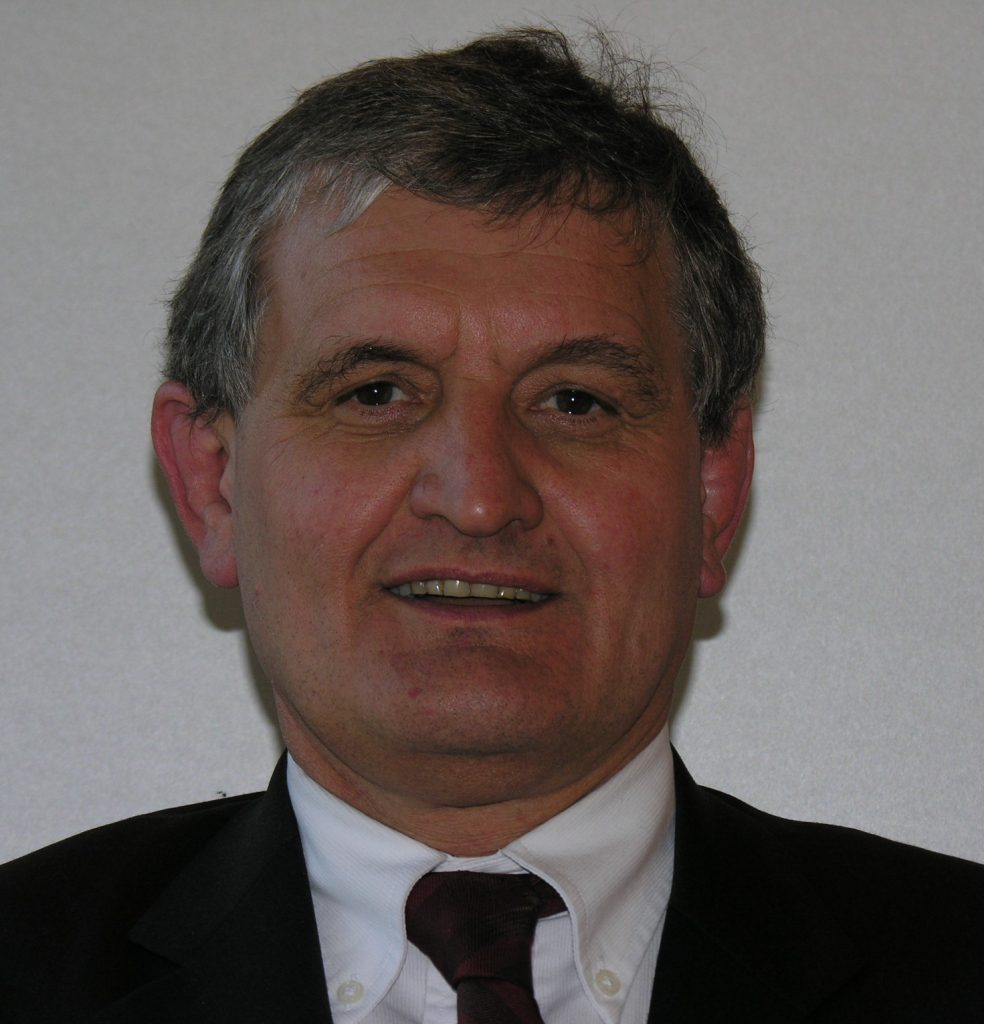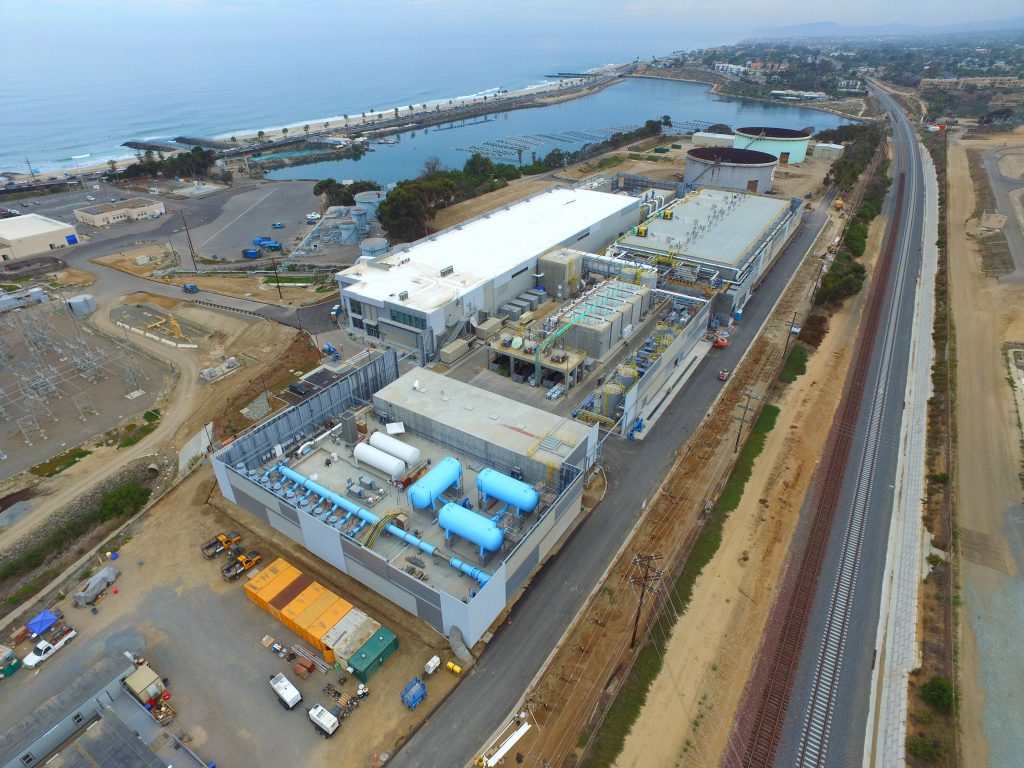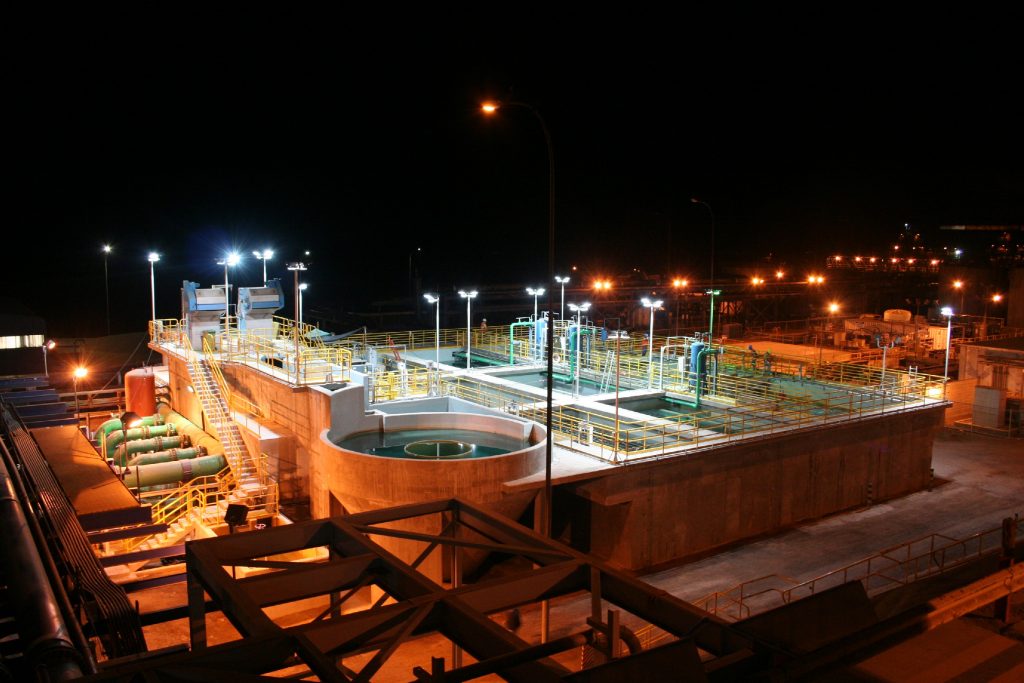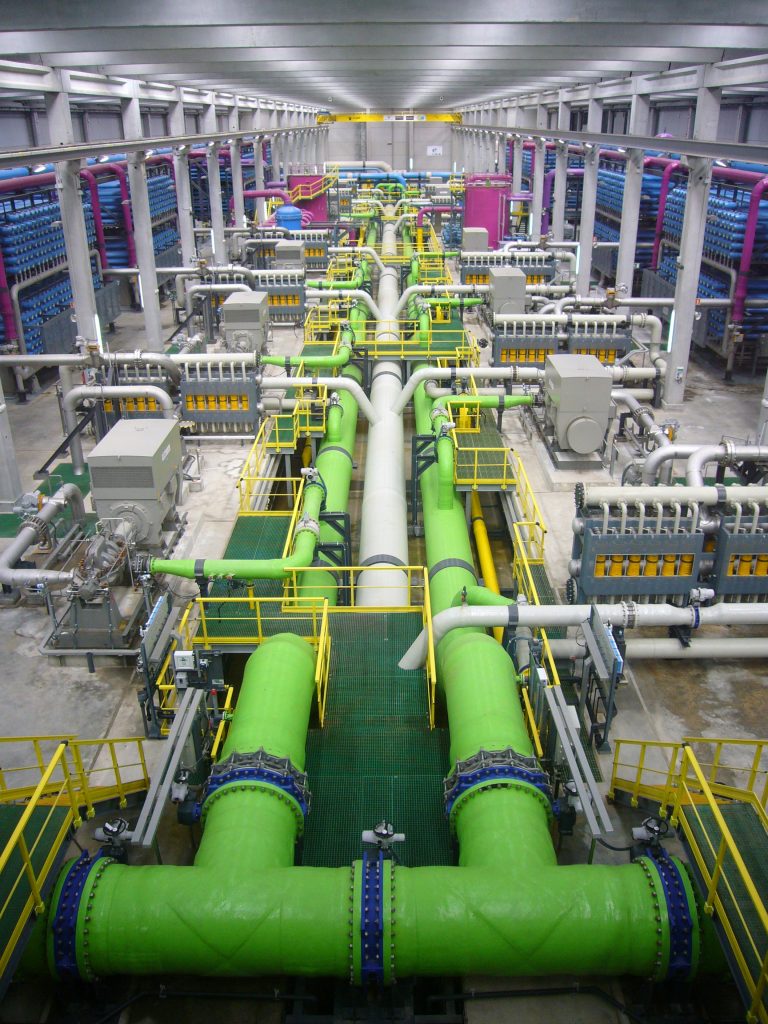The post Ultrathin graphene-oxide membranes used to filtrate water appeared first on The Source.
]]>New ultrathin membranes have been tailored so that all solvents pass through without compromising their ability to sieve out the smallest of particles. Previously graphene-oxide membranes were shown to be completely impermeable to all solvents except for water.
The study, published in Nature Materials, lays out the research led by Professor Rahul Nair at the National Graphene Institute and School of Chemical Engineering and Analytical Science at the University of Manchester. In the newly developed ultrathin membranes, graphene-oxide sheets are assembled in such a way that pinholes formed during the assembly are interconnected by graphene nanochannels, which produces an atomic-scale sieve allowing the large flow of solvents through the membrane.
“Just for fun, we even filtered whisky and cognac through the graphene-oxide membrane,” explained Professor Nair. “The membrane allowed the alcohol to pass through but removed the larger molecules, which gives the amber colour. The clear whisky smells similar to the original whisky but we are not allowed to drink it in the lab, however it was a funny Friday night experiment!”
This new research allows for expansion in the applications of graphene-based membranes from seawater desalination to organic solvent nanofiltration (OSN). Unlike seawater desalination, which separate salts from water, OSN technology separates charged or uncharged organic compounds from an organic solvent.
The newly developed membranes not only filter out small molecules, but boosts the filtration efficiency by increasing the solvent flow rate.
Professor Nair added: “Chemical separation is all about energy, various chemical separation processes consume about half of industrial energy usage. Any new efficient separation process will minimise the consumption of energy, which is in high demand now. By 2030, the world is projected to consume 60 percent more energy than today.”
Graphene-oxide membranes developed at the National Graphene Institute have attracted widespread attention for water filtration and desalination applications, providing a potential solution to water scarcity.
By using ultra-thin membranes, Nair says this is the first clear-cut experiment to show how other solvents can be filtered out, proving that there is potential for organic solvent nanofiltration.
The post Ultrathin graphene-oxide membranes used to filtrate water appeared first on The Source.
]]>The post Indian students win industry water prize appeared first on The Source.
]]>A national team of students from India have won the Xylem Water Prize 2017. Presented at the 14th annual International Junior Science Olympiad (IJSO) in the Netherlands, the theme of 2017’s IJSO was Water and Sustainability.
Team India’s video was deemed the winner for incorporating the three key elements to reduce, reuse, and recycle through the team’s floating solar-powered desalination plant. They were presented with a certificate and an iPad. To enter, invited participating students had to produce a video answering the question, ‘How do you solve water?’ All submissions were evaluated for impact, clarity, creativity and innovation by an international judging panel.
“The threats to our water resources have never been greater, but, increasingly, there are sustainable solutions to these challenges driven by advanced technologies,” said Patrick Decker, President and Chief Executive Officer of Xylem. “This is the next generation of the world’s problem-solvers and innovators and they won’t let their thinking or curiosity be constrained by the traditional models of the past.”
The 14th International Junior Science Olympiad was organised by the IJSO 2017 Foundation. During the competition, students were tested on their knowledge and skills in physics, biology and chemistry. The 2017 theme of Water and Sustainability’ was particularly fitting for the Netherlands–a nation that pioneered smart water management for generations.
“We find that one of the biggest obstacles and impediments to helping solve the water issue is education and awareness,” added Decker. “The fact that these teenagers are so excited by this cause and if I could capture that energy and that awareness and spread that across the planet, we’d solve water tomorrow.”
More than 300 students aged 15 years or younger from 50 different countries tested their scientific knowledge and skills in the competition.
The post Indian students win industry water prize appeared first on The Source.
]]>The post Cape Town begins site preparation for desalination plant appeared first on The Source.
]]>Seven projects have been earmarked as part of the first phase of the city’s Additional Water Supply Programme. These are the Monwabisi, Strandfontein, V&A Waterfront, and the Cape Town Harbour desalination plants; the Atlantis and Cape Flats Aquifer projects; and the Zandvliet water-recycling project, which will collectively produce an additional 196 million litres per day between February and July 2018.
“Being mindful of the potential financial impact on water users, the city has worked really hard to see what existing budget it has available by making tough choices and reprioritise spending to boost drought mitigation initiatives,” said Councillor Xanthea Limberg, the City’s Mayoral Committee Member for Informal Settlements, Water and Waste Services and Energy. “It is anticipated that the Monwabisi plant will produce a total of 7 million litres of drinking water per day which will be fed into the water reticulation system.”
A nine-week construction period is planned for the completion of the first phase, comprising of two million litres. The first drinking water generated by the desalination plant is expected to be fed into the reticulation system by March 2018 with the second phase of 5 million litres to follow on after a further nine weeks.
All plants will comply with national legislation, which also provides for some fast-track measures for disaster relief projects such as the city’s emergency projects.
“The plant is intended to operate for a period of two years, based on a service agreement in which the city has agreed to buy water from the service provider, Water Solutions Proxa JV,” added Limberg. “The value of the tenders for the establishment and operation of the desalination plant at Monwabisi for a period of 24 months is R260 million (US$20.6 million).”
The post Cape Town begins site preparation for desalination plant appeared first on The Source.
]]>The post New project enabling food production in harshest climates appeared first on The Source.
]]>In the first stage, the Sahara Forest Project aims to produce up to 130 tonnes of organic vegetables per year from just 7 acres of previously deemed ‘unusable’ land. The full scale of the project is set to reach 490 acres in the coming years.
“This is one of the most technically complex and satisfying projects we’ve had the pleasure to work on,” said Tom Bentham, Senior Partner at Max Fordham, an engineering firm collaborating with the Sahara Forest Project. “We’ve collaborated with experts across many countries and disciplines to bring this project to fruition. The salt water and desert environments are both testing on their own; when put together they create one of the harshest environments there is for engineering components.”
Max Fordham carried out research into technical aspects of the project including thermodynamic analysis of the greenhouse (to provide optimum growing conditions for crops with minimum resource input), desalination techniques, and the potential climatic effects of adding moisture to desert air.
The research included building and operating an experimental rig in the Qatari desert, to verify conclusions in the field. This culminated in the development of a mathematical computer model of the entire Sahara Forest Project system, which Max Fordham and SFP then used to investigate resource flows through the system and projected investment costs and returns.
“Jordan has a lot of sunlight, it has a lot of desert, it has sea water, it has CO2,” said Joakim Hauge, SFP Project Director. “That is what we need to produce food, water and renewable energy.”
The second stage of the collaboration was focused on the engineering design of the Sahara Forest Project system, firstly for the Pilot Project in Qatar, which opened in 2012 and operated for a year, then more recently for the larger launch station opened in Jordan. Max Fordham designed the saltwater cooling system for the greenhouse, as well as the services infrastructure, which joins up and enables the different energy and growing technologies, which comprise the SFP system.
The post New project enabling food production in harshest climates appeared first on The Source.
]]>The post Water security urgent priority in Middle East and North Africa, says new report appeared first on The Source.
]]>“If we think of water resources as a bank account, then the region is now seriously overdrawn,” said Hafez Ghanem, World Bank Vice President for the Middle East and North Africa. “Drawing water from rivers and aquifers faster than they can be replenished is equivalent to living beyond one’s means, and it undermines a country’s natural capital, affecting longer-term wealth and resilience. But there are solutions, and they start with clear incentives to change the way water is managed.”
Beyond Scarcity: Water Security in the Middle East and North Africa draws on regional and global examples to show that limited water resources need not restrict the region’s future, but that a combination of technology, policy and management can convert scarcity into security.
Offering a comprehensive analysis of one of the region’s most significant challenges, the report examines the sustainability and efficiency of current water resources management, the challenges to maintain and extend access to affordable water services, and the growth of water-related risks and the adequacy of the actions taken to address them.
“Along with better water management, there is room for increasing the supply through non-conventional methods such as desalination and recycling,” said Guangzhe Chen, Senior Director of the World Bank’s Global Water Practice. “Fortunately, many countries have demonstrated success in implementing innovative programmes to reduce the amount of treated water that is lost through leakages before it reaches the customer, as well as producing nonconventional water.”
Over 60 percent of the MENA region’s population lives in areas with high or very high surface water stress, compared to a global average of about 35 percent. Yet despite water scarcity, the region has the world’s lowest water tariffs and, at two percent, the highest proportion of Gross Domestic Product spent on public water subsidies.
Low service tariffs discourage efficient use of water. Increasing water service fees would signal the true value of the dwindling resources and encourage conservation. It can also provide financing for water resources protection, infrastructure maintenance, and ensuring equitable and reliable service delivery.
The potential for recycling has yet to be fully exploited in the region. Currently, more than half of the wastewater collected in the MENA region is returned to the environment untreated, resulting in both health hazards and wasted water resources.
The post Water security urgent priority in Middle East and North Africa, says new report appeared first on The Source.
]]>The post How big is the distributed energy opportunity for water and wastewater utilities? appeared first on The Source.
]]>Energy costs for water utilities are large, and growing
Energy is a significant cost for many water utilities, and costs are growing as more energy-intensive forms of water supply, including desalination, are being used. Energy is typically the second-largest utility budget item in developed countries, after labour. In many developing countries, energy can account for 70 percent or even more, of annual costs. But water and wastewater utilities can generate and export energy–in multiple forms.
Water utilities can generate significant flows of energy
There are many examples of water and wastewater utilities successfully implementing Distributed Energy Resources (DER) projects, to offset costs, improve reliability or meet other targets such as greenhouse gas emissions reduction. Biogas (digester gas), co-digestion of food waste, heat generation (incineration of sludges), wind- and hydro- turbines, solar photovoltaic, tidal and geothermal, algal systems and fuel cells are all practical examples that have been proven to work.
However, current generation of renewable energy by water and wastewater utilities is a fraction of its long-term potential. In the United States, municipal water supply consumed 40 billion kWh electricity, and wastewater treatment 30 billion kWh in 2012: collectively 2 percent of total national electricity use. Yet the thermal, chemical and hydraulic energy content of raw wastewater alone in the United States is ~150 billion kWh, with 80 percent of this as waste heat, and 20 percent as chemical energy.
Globally, a number of wastewater treatment plants, including Morgental in Switzerland, are capitalising on all these forms of energy, and expect to generate more than five times than the plant itself consumes.
Water utilities are well placed to connect to electricity, gas and heat grids
Water and wastewater utilities are often good candidates for Distributed Energy Generation, and integration with electricity, gas and heat grids. They often own large amounts of contiguous land, have high (and movable) energy demand, and have the ability to provide other services to the energy grid. However, this integration is slow. Of the approximately 837 biogas generating facilities in the US in 2013, only 35 percent generate electricity from the gas and only 9 percent sell electricity back to the grid.
Integrating with–not just connecting to–the electricity grid is key
Successful integration of DER systems into the electric power grid can be problematic when the grid is not designed to accommodate high penetration of DER. To realise fully the value of DER and to serve consumers reliably, integrated planning–and an Integrated Grid–is needed.
Lack of co-ordination, is creating a wide set of barriers to integration and a raft of additional challenges exist including policy instability, guarantees, reliability, and maintenance responsibility. Identifying best options, and navigating regulatory requirements, tariffs and other barriers is a significant–and exciting–challenge for water and wastewater utilities.
The lack of integration is broader than DER, with limited “integrated planning” across the water and energy sectors more generally. This is partly due to significant inter-sectoral differences, and a lack of a common language also hinders solutions–who in the water industry talks of drop function or voltage harmonic distortion? Another limiting factor is the global paucity of integrated training across the water-energy divide.
Help us improve integration of distributed energy systems
The Water Research Foundation and Water and Environment Reuse Foundation, are undertaking a study to understand and improve integration of distributed energy into water and wastewater utilities. The research is led by The University of Queensland, Australia and the survey will be open until 23 May 2017.
Take the survey now: https://remsurvey.rem.sfu.ca/DER4625/
For more information:
- Take the DER survey https://remsurvey.rem.sfu.ca/DER4625/
- Consider masters-level water-energy training https://www.uq.edu.au/study/program.html?acad_prog=5410offered through http://www.watercentre.org/
- Read about integrated water-electric utility planning http://www.waterrf.org/Pages/Projects.aspx?PID=4469
- Read about the DER project http://www.waterrf.org/Pages/Projects.aspx?PID=4625
- Contact Steven Kenway kenway@uq.edu.au
The post How big is the distributed energy opportunity for water and wastewater utilities? appeared first on The Source.
]]>The post When is desalination the right choice? appeared first on The Source.
]]>Jonathan Andrews spoke to a select panel to break down some of the more common controversies surrounding desalination, and asks if water scarcity can make desalination plants environmentally, financially and politically feasible
When–if ever–will desalination become economically and politically competitive with other water supply options for thirsty cities?
 Michel Canet, Business Development Advisor, Veolia Water Technologies
Michel Canet, Business Development Advisor, Veolia Water Technologies
Take Saudi Arabia as an example where thermal multi-stage flash [MSF] plants have been installed for more than 30 years. It is clear that the only economical and political water supply option is to continue to use desalination but the authorities should take into account the availability of new technologies such as multiple- effect distillation [MED] and reverse osmosis [RO], which can be combined. A 15-year-old MSF plant can be replaced by a hybrid plant of MED and RO technology to produce more than double the quantity of water with less electricity and steam consumption.
 Heather Cooley, Co-Director, Water Programme, Pacific Institute
Heather Cooley, Co-Director, Water Programme, Pacific Institute
Desalination is among the most expensive options, and water managers may reduce the output of a desalination plant when demand drops or when less expensive options are available. Because of the fixed costs of the plant, reducing the output can increase the unit cost of the water produced which can further reduce demand or make other supply options even more economically attractive. In response, water managers may temporarily or permanently shut down the desalination plant. This can reduce the variable operating costs associated with the plant but ultimately leave ratepayers to pay off a plant while receiving little to no benefit from it. This would be a disservice to the community and the industry.
 Emilio Gabbrielli, Director, Overseas Business Development, Toray and President of the International Desalination Association (IDA)
Emilio Gabbrielli, Director, Overseas Business Development, Toray and President of the International Desalination Association (IDA)
It already is. If fact, when you consider both desalination per se and advanced reuse, these should be considered as complements or alternatives to mainstream water supply in most situations where water resources planning is done. The technology involved is mature and reliable, and costs are often competitive with traditional treatment processes. In many cases, they are actually already cheaper, not only safer in terms of quality. The value of desalination and advanced water reuse is being recognised more and more, and political interest and support to explore these alternatives is growing fast.
 Denys Neymon, Chief Executive Officer, Treatment Infrastructure and Executive Vice-President, Suez
Denys Neymon, Chief Executive Officer, Treatment Infrastructure and Executive Vice-President, Suez
For coastal cities, desalination is a complementary solution to other water supply systems. It is the best and only solution when no other options are available, and due to its cost of under US$1 per cubic metre, it is always economically and politically competitive, especially for coastal cities in developed countries.
 Shannon McCarthy, Co-Founder and Partner of United4Water and 1st Vice-President, International Desalination Association (IDA)
Shannon McCarthy, Co-Founder and Partner of United4Water and 1st Vice-President, International Desalination Association (IDA)
Desalination is not in competition with dependable conventional water sources. Desalination competes economically and politically with the costs of no freshwater at all or inadequate quantities of freshwater. Desalination can provide a sustainable source of freshwater for coastal cities that have either limited or no dependable freshwater sources. More than 300 million people around the world rely on desalinated water for some or all of their daily needs. Increased efficiency has already achieved substantial reductions, and there is every indication it will continue to do so.
 Adam Scow, California Director, Food & Water Watch
Adam Scow, California Director, Food & Water Watch
Smart water agencies are making great strides in adopting efficient water management practices such as conservation, groundwater cleanup, reuse, and recycling. Desalination is an expensive and speculative option that could drain resources away from these and other more practical solutions. It should only be the option of last resort after all other and better supply options have been fully developed. Desalination will not fix or make up for the many water abuses and blunders that exist in the world today.
 David Zetland, Assistant Professor, Leiden University College
David Zetland, Assistant Professor, Leiden University College
Constantly improving technology means lower costs for desalination, but also lower costs for similar technology like wastewater recycling. Cities interested in saving money should therefore always consider recycling before desalinating water. From a political perspective, this can also be easier, as wastewater is easier to access than salty or brackish water that may be part of fragile ecosystems. Both of these technologies are less efficient than using rain water and cheaper surface and ground sources, of course, so we’re talking about ‘always more competitive, never the most competitive’.
How might desalination cause as many problems as it solves, or indeed solve more problems than it creates?
Canet, Veolia
It is difficult to weigh the social developments of a remote and thirsty region created by the viability of desalinated water versus the environmental problems created by brine rejection, global warming pollution, and water pricing for a low-income community. The only recommendation is that desalination projects should be done after a detailed feasibility study where comparisons between alternative solutions such as wastewater reuse, ground water, or recharged water tables are available for a final decision.
Cooley, Pacific Institute
Poorly planned, sited, or executed desalination projects would create as many or more problems than they solve. Indeed, the siting, building, and operation of desalination facilities are likely to be delayed or halted if local conditions, sentiments and the public interest are not adequately acknowledged and addressed. To help address these issues, the process of designing, permitting, and developing desalination facilities must be transparent and open. Moreover, affected community members should be invited to participate in desalination project planning, implementation, and management during the early stages of the process.
Desalination solves problems; it does not create them. It is an essential part of the water supply in many parts of the world, providing vital freshwater resources to growing populations and economies. It is unique in its ability to provide our thirsty planet with the only new and reliable source of freshwater. As our world deals with increasing water scarcity and the effects of climate change, seawater desalination becomes an ever more important strategy to ensure an adequate and essentially drought-proof supply of freshwater.
Neymon, Suez
Where there is a shortage of resources, desalination is the only solution able to supply water and thus, allow human development. Its outcomes are more positive than the effects resulting from its higher energy consumption compared to conventional solutions, or the discharge of concentrated water (brine) in the sea. In the last 20 years, energy use has significantly fallen. For example, daily energy consumption to supply desalinated water to a family of four is the equivalent to ironing clothes for one hour or using a laptop for a day.
McCarthy, United4Water and IDA
It is difficult to visualise a situation where desalination causes more problems than it solves or fails to solve more problems than it creates. Desalination requires energy, however there is great progress in the use of clean, renewable energy for desalination. The first utility size desalination plant using concentrated solar power (CSP) is under construction in Saudi Arabia. Seawater desalination plants must have dilution methods and outtakes that are carefully and correctly designed to discharge the treated brine at distances and depths that avoid harming the marine environment and marine life. For inland facilities that are desalinating brackish ground water, there is promising ongoing research in chemical and electrical methods of extracting the salt from the resulting brine. These could also be used to reduce brine from seawater desalination.
Scow, Food & Water Watch
Desalination creates many problems. It can be greater than ten times more energy intensive than other supply sources, thus potentially spurring their emission of global warming pollution. Producing water through ocean desalination costs three or more times what it costs to produce water from traditional supplies. It often requires multiple subsidies of both water and electricity to break even, and it entails pricey upfront construction and long-term operation and maintenance costs. Many proposed ocean desalination plants are now planning to rely on ‘once-through’ intake structures that kill fish and other organisms. Further, the disposal of the brine also has the potential to upset our delicate coastal ecosystems.
Zetland, Leiden University College
Desalination adds to supply, thereby reducing water scarcity. If demand is not capped (growth continues; lawns get bigger, and so on), then scarcity will return. The water authority in San Diego is bringing in desalinated water supplies of about 7 percent of total use but spreading US$1 billion of new costs among all customers. The small change in price is unlikely to dampen demand from existing customers or people moving to the area, which means that San Diego will again face water scarcity problems in the future.

Which beneficiaries should directly underwrite or finance investments in desalination plants, and why?
Canet, Veolia
With energy being the key element in producing desalinated water, it seems normal to consider that large energy producing companies like EDF, ENGIE, ACWA Power, and others should be investors. However, very often the costs of desalinated water is greatly affected by financing constraints and guarantees required by banks, so it could be cheaper to require governments or international financial institutions to give soft loans and/or guarantees to such projects.
Cooley, Pacific Institute
The financing of a desalination plant will depend on the unique circumstances of a given project. As a general rule, all beneficiaries of the desalination plant should pay for a portion of the project. The water users are the major beneficiaries of a project and would therefore likely bear much of the cost. Companies that profit from the project are other possible beneficiaries. Public subsidies are only appropriate in cases where the facilities come with an explicit guarantee of public benefits, such as restoration of ecosystem flows.
Gabbrielli, Toray and IDA
As desalination and reuse have become a mainstream freshwater supply alternative, their underwriting or financing will follow the same pattern as with other freshwater resources. This is clearly the case with municipal water utilities, whether this is done on a direct investment basis or through a form of public-private partnership. What seems to be happening more is that industries are deciding to invest in desalination and reuse within their fences to become independent from the services of the local utility. This is also done to secure its water supplies in case the utility has to cut the supply in a situation of drought, when supply for human consumption takes priority.
Neymon, Suez
Most desalination plants are used for drinking water supply. Therefore the public sector has to underwrite such projects to guarantee delivery and attract contractors. In some projects, the private sector could become involved through a dedicated investment vehicle that will need to be endowed with guarantees to deliver the project, securing its financing. Such guarantees come from the public sector such as land agreements, water purchase agreements, electrical connection agreements, and others.
McCarthy, United4Water and IDA
Financing should be shared between government agencies originating the projects and private sources of finance investing in the construction and operation of the plants. Governments should finance the infrastructure for water distribution and wastewater recovery. Private capital should finance the plants and their supporting facilities. Government contracting and regulatory policies should facilitate this combination.
Scow, Food & Water Watch
Ocean desalination provides a new opportunity for private corporations to own and sell water, creating the possibility that private corporations would rate-gauge thirsty populations. Food & Water Watch values water as a public resource that must be managed by public institutions and not be privatised. A recent Food & Water Watch analysis compared average water rates charged by publicly and privately owned utilities in four US states–California, Illinois, Wisconsin, and New York–and found that privately owned water utilities charge customers significantly higher water rates than their publicly owned counterparts: anywhere from 13 percent to almost 50 percent more.
Zetland, Leiden University College
The users of the water, and in particular the new users of the water should be the underwriters. Economists tend to say that everyone should face the marginal cost of their use, that is the cost of getting another unit, to help them see the real cost of scarcity. Most water utilities charge average costs, which means that people use too much water. Say, for example, you get half your supply from groundwater that costs US$1/m3 and half from desalinated water that costs US$2/m3. Most utilities would sell that water at US$1.50/m3, which does mean that costs match revenues, but also means they are selling US$2 water for US$1.50. It’s much better– from the perspective of efficiency and fiscal security–to charge US$2/m3 on all water. The utility can then send back the ‘profits’ (on groundwater) by reducing fixed charges to customers. This works for all water supply systems, but it’s especially useful for desalination because it’s so expensive.

When is small, distributed or large- scale centralised desalination preferable?
Canet, Veolia
A key factor for desalination plants is energy. The drive behind installing a small or a large centralised desalination plant is the availability of energy at a given location. This means that when there is no issue to build a large power plant then a large desalination plant is obvious. However, when you use the grid or use small solar or wind power, then a small plant is better.
Cooley, Pacific Institute
The unit cost of water from small systems is typically more expensive than large systems due to economies of scale. As a result, project developers may build large plants in an effort to capture economies of scale and reduce the unit cost of water; however, this can lead to oversized projects that ultimately threaten its long-term viability. As a general rule, the size of the facility should be determined by the demonstrated need for the water produced. Additional capacity to desalinate water can be added as needed.
Gabbrielli, Toray and IDA
Careful estimates of the costs of distribution associated with the alternative number of plants and sizes have to be looked at in their entirety, and the most economical solution should be chosen. In areas with several small centres within a reasonable number of kilometres, the alternative to provide a centralised desalination plant and then distribute the product by pipe or tank trucks can produce a result similar to that of providing individual small-scale plants. In many cases, the apparent safety of a centralised operation can be offset by the increased reliability of an operation ‘bought’ by the same community, which takes direct responsibility.
Neymon, Suez
From an economic and lower water rates perspective, a large-scale centralised desalination plant is preferable, except if the distance to feed the population is too far, and huge networks and pumping stations are required. Only in isolated villages or regions, is building small plants an acceptable solution, combining them with the use of renewable energies.
McCarthy, United4Water and IDA
Transporting water is expensive. Small, distributed desalination facilities are best suited for the desalination of brackish groundwater. Smaller seawater desalination plants are also appropriate for coastal towns. Large- scale desalination is best suited for seawater desalination for large coastal urban areas or industrial complexes.
Scow, Food & Water Watch
Small is preferable, but only if absolutely necessary and all other options have been exhausted.
Zetland, Leiden University College
Scale should reflect political realities. A smaller plant may serve a single community better than a larger one that drives conflict among several communities sharing it.

How can desalination best mitigate and address the high energy, cost, and toxic effluent from membrane problems? And what is the best way to reduce the environmental impact of polluted membranes after use?
Canet, Veolia
Firstly developments of new membranes, energy recovery systems and new processes for pretreatment have already addressed the cost and the high-energy consumption for desalinated water. New developments such as forward osmosis and hybrid desalination are going to further reduce costs and energy consumption. What to do with used membranes is indeed an issue but we should consider that membrane life has been considerably increased and it is now standard to change membranes after only eight to nine years. Often those used membranes can be used a second time for a few more years. In addition, recycling companies have not looked at membrane products yet, as the quantities are quite small, but in a few years there may well be a solution and a recycling process found.
Cooley, Pacific Institute
Desalination increases the water supplier’s exposure to energy price variability and greenhouse gas emissions. Some of the most promising research on reducing energy use is focused on alternative desalination technologies, like forward osmosis and membrane distillation; hybrid membrane-thermal desalination; and improved energy recovery devices. While reducing energy use will reduce greenhouse gas emissions, other mitigation strategies include using renewable energy and purchasing carbon offsets. Even renewables have a social, economic, and environmental cost, albeit much less than conventional fossil fuels. Marine impacts of desalination must be understood and mitigated. More research is needed, especially on the long-term impacts. We do, however, know that there are several operational, design, and technological measures available to reduce the marine impacts of open water intakes and brine disposal.
Gabbrielli, Toray and IDA
The high-energy costs of desalination are partly a myth, as by now desalination and reuse often uses less energy than traditional treatment methods or transferring water from farther away. With known technologies like reverse osmosis, there is not much scope for further reduction in energy consumption. Where there is great potential is the increasing use of renewable energy in its several forms for desalination. Luckily desalination normally does not produce problematic wastes, and the concentrate, in the case of seawater desalination, is nothing more than concentrated seawater that can be discharged with practically no environmental effect if the discharge is located and designed correctly.
Neymon, Suez
Energy use is relative, and in the last 20 years, it has significantly fallen. The desalination market is so competitive that the cost of desalination plants has diminished over the years. While it remains a costly process among drinking water treatments, it should be pointed out that the water produced is of exceptional quality. When membrane production capacity is reduced, and they have reached the end of their lifecycle, the best way to discard them is to recycle their components, and incinerate them jointly with domestic waste making them a source of energy generation.
McCarthy, United4Water and IDA
In the last decade, advances in desalination technology have reduced the cost of membrane desalination by 50 percent. Energy is the largest single cost of desalination (44 percent of the total). The reduction means significantly less energy is required. An alternative to fossil fuels is the use of renewable energy, solar or wind, which has no emissions and, after the initial investment, much lower costs. Many regions where desalination is needed have ample sunshine. The newly formed Global Clean Water Desalination Alliance, H2O minus CO2, is promoting the use of renewable energy for desalination. The alliance was launched at the Paris Climate negotiations and aims for 80 percent to 100 percent of new desalination plants and at least 10 percent of old plants to be powered by clean energy by 2035.
Scow, Food & Water Watch
Because there are no ways to truly mitigate these major impacts, and better options exist, desalination should not be pursued in general.
Zetland, Leiden University College
I’d encourage the use of ‘best technology’ by making polluters pay for whatever impacts they are generating.
The post When is desalination the right choice? appeared first on The Source.
]]>The post H2O minus CO2: How mitigation and money savings are driving emissions-free desalination appeared first on The Source.
]]>By Bill Hinchberger*
Consider the catch-22 for Pacific islanders. They lack sufficient freshwater to meet growing demand. While desalination could boost supply, each plant’s energy-intensive greenhouse gas emissions would help raise sea levels, further threatening the islanders’ existence.
The desalination industry is booming. Investment in new plants topped US$21 billion last year, according to Massachusetts-based BCC Research, and that amount is expected to double by 2020. The world’s 18,000-plus desalination plants are almost all powered by fossil fuels.
But that may be changing. There seems to be a move, especially by newly designed off-grid desalination plants, to reduce carbon footprints through renewables such as solar, wind, wave/tidal and geothermal–sometimes even nuclear.
Interest is strongest “in locations where energy availability is as constrained as is water availability,” according to Steven Schonberger, Practice Manager of the World Bank’s Water Global Practice.
Initiatives can be found in outlying regions, rural areas, islands, businesses, resorts, and other remote locations. The Middle East North Africa (MENA) region leads the way, but people are busy working on alternatives around the globe–from Hawaii to Egypt’s Red Sea resorts.

“At a recent conference in Trinidad and Tobago, 60-70 percent of the papers were about renewable energy for desalination,” recalls Gilad Cohen, VP of sales and marketing, North and Latin America at IDE Technologies, a subsidiary of the Israeli desalination firm. “There is a growing trend.”
The efforts are part of a new equation that may have broader implications. The Global Clean Water Desalination Alliance (GCWDA) calls it “H2O minus CO2”.
GCWDA was founded during the COP21 climate change summit in Paris. The multi-stakeholder group of 80 original signatories included public, private and civil society representatives. Their mission: guarantee that 80 percent of new desalination plants and at least 10 percent of the total run on renewable energy by 2035.
“I believe that we are approaching a revolution in renewables,” says Leon Awerbuch, Director and Dean of the Academy at the International Desalination Association (IDA), a trade group and founding member of the GCWDA. “With that there will be enormous potential [for renewable energy in desalination].”
There’s more than climate correctness alone driving this phenomenon. The cost of solar and wind power are starting to compete head-to-head with fossil fuel.
Industry insiders point to the Dubai Electricity and Water Authority (DEWA) for its projected 800 MW Sheikh Maktoum Solar Park Phase III plant. A bid in May rang in at US$2.99 per kilowatt-hour (kWh), breaking the three-dollar barrier for the first time for solar, trouncing fossil fuel’s hypothetical best price.
“Renewables can now compete with fossil fuel on an economic basis,” says Awerbuch. “This is not just about being green or climate change. It is economically driven.”
In isolated areas, the economics behind alternative energy are even more favourable. “There is the issue of transporting the oil and generating the needed electricity, which is beyond the capabilities of many parts of the world,” says Philip Moravcik, a technology transfer specialist at the University of Hawaii at Manoa’s Water Resources Research Centre. “If you can generate energy with minimal external inputs, that is attractive.”
Truly far-flung islands face looming operations and maintenance challenges. Normally plant managers would have to train or recruit skilled people to work full-time on site.
But advances in information and communications technology are offering a novel solution. “The next phase is to make remote operations feasible,” says Clark C.K. Liu, Professor Emeritus and Researcher in the Department of Civil and Environmental Engineering at the University of Hawaii at Manoa. “We could then operate the facilities in Hawaii, several thousands of miles away, using satellite communication.”
Advances in desalination technologies help decision-makers rethink their energy options. If less energy is needed, clean options might be considered for their environmental benefits even where they remain more expensive. “We try to improve the carbon footprint and reliability,” notes Schonberger. “We start with efficiency and then add incremental energy sources. We try to get the water- energy efficiency moving in the right direction with the right technologies.”

Many places boast just as much sun and wind as countries of the MENA region. What sets places like Dubai, Abu Dhabi and Saudi Arabia apart are their public policies, says Awerbuch, stressing that the right regulatory environment is essential.
“They are all pushing hard for renewable energy,” he says. “It starts with public policy. We need governments and utility companies to understand the benefits and recognise that this is not just a fashionable trend.”
Reliability remains the main drawback for the two leading renewable sources. No sun, no wind: no power. “Storage options are improving but there are limitations,” says Schonberger. To solve the intermittence problem, he added, project designers consider “a combination of renewables and conventional energy if they need a constant flow.”
Land use also complicates options. Solar and wind “are land-intensive,” observes Schonberger. The Palestinian Authority ran into that wall when it considered building a desalination plant in Gaza. There’s plenty of sunlight but not enough open space in the densely-populated area, said the World Bank official.
While hardly an environmental darling, nuclear energy can provide a constant current and doesn’t need quite so much land. “The feasibility of integrated nuclear desalination plants has been proven with over 150 reactor-years of experience, chiefly in Kazakhstan, India and Japan,” relates the website of the World Nuclear Association, an industry group.
Not everyone is convinced. “It is unlikely just to power a [desalination] plant,” argues Schonberger, adding that nuclear reactors could be built in parallel with desalination plants if connected to the grid. “We are debating nuclear. There is some disagreement,” says Awerbuch.
For a thirsty world facing a changing climate, desalination and affordable no-carbon energy might seem like the proverbial match made in heaven.
But Schonberger offers a final word of caution. “We have to be careful that having a readily available energy source doesn’t lead to over-exploitation.”
The post H2O minus CO2: How mitigation and money savings are driving emissions-free desalination appeared first on The Source.
]]>The post Hong Kong pursues renewable water sources appeared first on The Source.
]]>The plans were outlined by Enoch Lam, Hong Kong’s Director of Water Supplies, during the Eco Expo Asia event in Hong Kong (26-29 October). Lam said the Tuen Mun Water Hydro plant will provide 10 percent of the city’s electricity once it opens in February.
“More hydroelectricity options are being explored as part of our total water management strategy that uses adaptation, mitigation and resilience as we face climate change threats,” he said.
Pilots have also been launched that include floating solar panels on reservoirs that can supplement the power supply, wave power and refitting 60 government buildings and schools to recycle rainwater.
In terms of conserving water the government launched a campaign to reduce each citizen’s use by 10 litres a day and has installed an intelligent water network, dividing the city into 2,000 district metering areas. Each area includes monitoring and sensing equipment that can actively detect leakage and send a team out for a speedy repair.
“While the government is happy to take the lead we still need to collaborate with the community and get them on board to participate,” added Lam.
Ways in which the city is further attempting to get citizens on board is through education centres, best practice audits for hotels and businesses and in November the city will host a water conservation week.
Lam later outlined that as Hong Kong grows and builds housing in the New Territories those new developments will be more self sufficient with water supplies.
“They will have their own water resources through a combination of measures as it simply does not make sense to pump water and wastewater such large distances,” he added.
Lam concluded that the city’s total water management strategy, released in 2008, is currently under review and will be updated next year.
The post Hong Kong pursues renewable water sources appeared first on The Source.
]]>